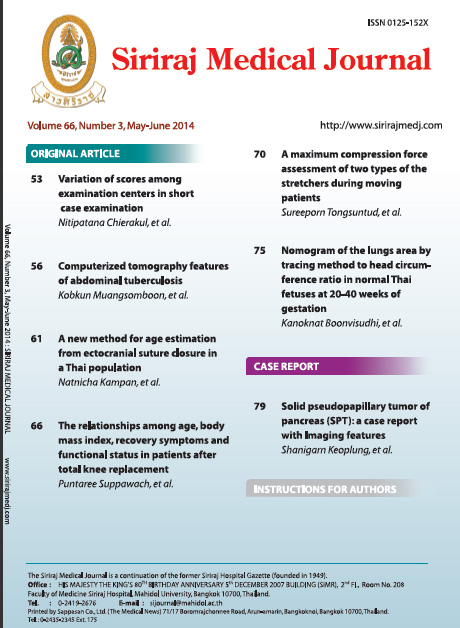A New Method for Age Estimation from Ectocranial Suture Closure in a Thai Population
Abstract
Age estimation is one of the major components of forensic identification. Cranial sutures have long been used as indicators for age estimation, because they vary in their timing of closure with age. The purpose was to estimate age in 100 Thai skulls with age ranging between 15-96 years from the Department of Anatomy, Faculty of Medicine, Chiang Mai University by using a new method for assessing ectocranial suture closure. Cranial sutures were the coronal, sagittal and lambdoid sutures on the ectocranial surface. In order to investigate the closure, obliteration of each suture was recorded using two techniques: photographing and tracing. The degree of suture obliteration was measured by counting the pixels of the remaining sutures using ImageJ software. The length of each suture was recorded in centimeters and the number of pixels per centimeter in each suture was analyzed using Pearson’s correlations at the 0.05 significance level. The results showed a significant negative correlation between age and the number of pixels per centimeter only in the coronal suture, and only when measured from tracing. A predictive model established using stepwise linear regression in this study was age = 76.872 – (19.609 x the number of pixels per centimeter in the coronal suture from tracing) + (3.710 x the number of pixels per centimeter in the lambdoid suture from tracing), with a standard error of ±13.9 years. Since this is the first attempt at age estimation using this method in Thailand, these results may assist in estimating age in forensic anthropological contexts.
Keywords: Age estimation, ectocranial suture, Thai population
Siriraj Med J 2014;66:61-65
Downloads
Published
How to Cite
Issue
Section
License
Authors who publish with this journal agree to the following conditions:
Copyright Transfer
In submitting a manuscript, the authors acknowledge that the work will become the copyrighted property of Siriraj Medical Journal upon publication.
License
Articles are licensed under a Creative Commons Attribution-NonCommercial-NoDerivatives 4.0 International License (CC BY-NC-ND 4.0). This license allows for the sharing of the work for non-commercial purposes with proper attribution to the authors and the journal. However, it does not permit modifications or the creation of derivative works.
Sharing and Access
Authors are encouraged to share their article on their personal or institutional websites and through other non-commercial platforms. Doing so can increase readership and citations.










